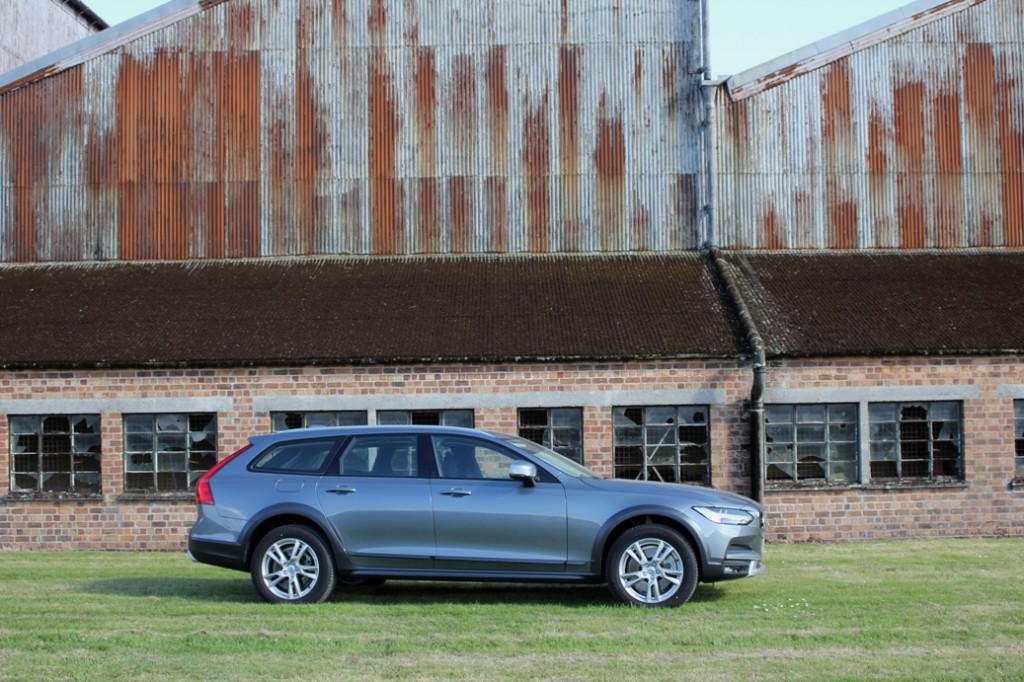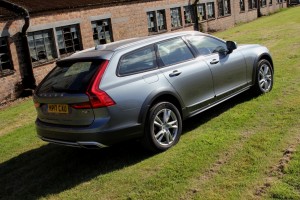… Volvo V90 Cross Country D4 …
When Geely bought Volvo back in 2010, there must have been some within the Chinese company who wanted to ‘tinker’ with the Swedish icon. Fortunately, they didn’t and instead left the Volvo team to get on with doing what they do best, making motoring safer and more enjoyable while innovating and engineering desirable motor cars. And when you drive the V90 you realise why.
 In fact, when I first drove the V90 at its Scottish launch, a fanciful notion entered my head whilst taking it for its maiden drive. Why would someone would want a Bentley or a Rolls Royce when the Volvo can offer equally acceptable levels of refinement. Of course that’s silly, if you’ve got the dosh, why not? But for those of us of more modest means, but similar automotive aspirations, Volvo can give the more exclusive marques a run for their money.
In fact, when I first drove the V90 at its Scottish launch, a fanciful notion entered my head whilst taking it for its maiden drive. Why would someone would want a Bentley or a Rolls Royce when the Volvo can offer equally acceptable levels of refinement. Of course that’s silly, if you’ve got the dosh, why not? But for those of us of more modest means, but similar automotive aspirations, Volvo can give the more exclusive marques a run for their money.
This is an eminently comfortable and relaxing car to drive. Not just because of the additional 65mm ride height over the standard estate car, but because the test car came with what Volvo calls its ‘Active Four-C Chassis’, a £1500 optional extra. The system comprises steel springs at the front and air suspension at the rear plus active damping at all four corners. It’s so effective that it merely shrugged off the so-called traffic calming raised lumps of square tarmac scattered around my area.
It has the same calming effect on forestry roads. It doesn’t lurch over pot holes and tracks, it glides. All wheel drive also adds another welcome capability, especially living and working in Scotland.
That ride quality is even better on smooth tarmac, or over British broken tarmac, and no doubt led to my initial observation when I first drove the car.
 In fact, the only glitch in forward progress comes from the 8 speed automatic gearbox. Most of the time you forget it’s there, but on the slowing down approach to roundabouts and junctions there can be a noticeable hesitancy to accelerate if a gap in the traffic is spotted. On the other hand, if you are expecting it you can plan for it. In fact it encourages you to drive rather more responsibly. There’s no point in rushing up to roundabouts and tearing away from them. Just sit back, breathe, lighten up and enjoy the ride. Arrive at your destination stress-free and in a good mood!
In fact, the only glitch in forward progress comes from the 8 speed automatic gearbox. Most of the time you forget it’s there, but on the slowing down approach to roundabouts and junctions there can be a noticeable hesitancy to accelerate if a gap in the traffic is spotted. On the other hand, if you are expecting it you can plan for it. In fact it encourages you to drive rather more responsibly. There’s no point in rushing up to roundabouts and tearing away from them. Just sit back, breathe, lighten up and enjoy the ride. Arrive at your destination stress-free and in a good mood!
The 2 litre diesel is also rather more relaxing than it is sporting. With 178 bhp on tap and 1.8 tonnes to shift, performance is adequate rather than quick, although if you want ‘quick’ there is the 316 bhp T6 petrol engine! In fact, there are two diesel options, with the D5 offering a bit more poke with 232 bhp.
However, the mid range torque of the D4 will be more than adequate for most drivers, and it perfectly matches the car’s impeccable road manners. No doubt the quoted 50 mpg plus fuel consumption will be another persuader although to be fair, I barely managed 40 over a 250 mile trip.
Completing the comfort package is the interior refinement. Sumptuous front leather armchairs are gently shaped to cosset rather than clasp with plenty of head, shoulder and leg room front and rear.
Contrasting the gentleman’s club-like interior is the modern electronic dash. The large digital touchscreen is too clever by half. There are so many options available through the myriad of Menus that if you find a feature you like, such as the fuel consumption graph or the interior lighting options, it is often difficult to navigate back to it. No doubt this will become more familiar with use, but for first-timers it can be quite confusing.
 As ever, considerable thought has been given to the estate car interior. The rear seats fold flat at the touch of a button, although they can be quite heavy to lift back into place. The boot utilises a simple solution for containing luggage. Instead of sliders or belts, there is a simple fold up partition to keep the weekly shopping in place. Why over complicate matters with infinitely adjustable straps?
As ever, considerable thought has been given to the estate car interior. The rear seats fold flat at the touch of a button, although they can be quite heavy to lift back into place. The boot utilises a simple solution for containing luggage. Instead of sliders or belts, there is a simple fold up partition to keep the weekly shopping in place. Why over complicate matters with infinitely adjustable straps?
In addition to the ‘Active Four-C Chassis’, the test car had the Sensus Connect system with Bowers & Wilkins audio, at which some might baulk considering the additional price of £3000, but there is a £300 charge for smartphone integration and £400 for a reversing camera pushing the price of this car to over £40,000.
Once upon a time I was the proud owner of a Volvo 740, and loved it. If I had a V90, I reckon I would end up loving that too.
Oh, and the wife liked it. Now there’s a recommendation, eh?